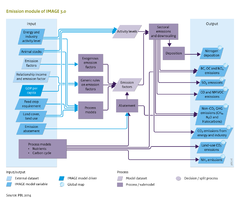Emissions/Data uncertainties limitations
Parts of Emissions/Data uncertainties limitations
| Component is implemented in: |
Components:and
|
| Projects/Applications |
| Models/Databases |
| Key publications |
| References |
div class="page_standard">
Data, uncertainty and limitations
Data
Global emission data are provided in a range of inventories. The EDGAR database (JRC/PBL, 2012) was preferred for IMAGE because of its high level of detail and the similar sectoral and regional definitions. Alternative inventories include the database underlying the RAINS/GAINS system, the RETRO database and the RCP database (Lamarque et al., 2010). An overview of available inventories by Granier (2011) has shown large differences between the databases for carbon monoxide, nitrogen oxides, sulphur dioxide and black carbon on global and regional scales. Most emission factors for land-use emissions are based on IPCC methodologies and parameters (IPCC, 2006)
Uncertainties
EDGAR data on activities and emission factors need to be aggregated in order to be used in IMAGE. In this process, decisions need to be made (e.g., on the use of weighted averages and representative sectors), which lead to additional uncertainties. In general terms there are three levels of uncertainty. For energy and industry, emission factors for CO2 are less uncertain than those for non-CO2 emissions. In turn, the uncertainty in emission factors for land use and natural sources is larger than for energy and industry sources because of the extreme variability of the factors controlling processes in space and time.
Future emissions and their uncertainty depend on the activity levels determined by other IMAGE components, and on the emission factors. Estimations of future emission factors in the energy and industry systems, described above, rely on historical observations and learning curves. However, future legislation and effective implementation may influence these factors more, and more abruptly. Emission factors for land-use activities may change in the future, also in the absence of climate policy, but are assumed to be constant because of lack of data. As the future development of emission factors is per definition uncertain, the influence is explored by changing the emission factors for different storyline-based scenarios.
Limitations
IMAGE covers almost all emission sources and gases within a consistent framework, based on a few international data sets and authoritative sources. However, some specific emissions are only included as a group, without the underlying production processes. Even more importantly, IMAGE does not include emissions from peat and peat fires, although they constitute an important source of air pollutants and CO2 emissions (IPCC, 2007a).
